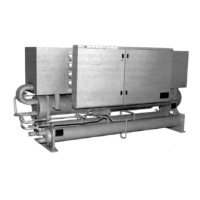Product Manual WHR-2 15
Solution:
1. Chilled water range: 54°F - 44°F = 10°F (Temperature Difference).
2.
24
Range Water ChilledGPM
=Capacity
×
= 68.8 tons
165 10
24
×
3. From Table 6, a model WHR-070EW has the capacity to meet the job requirement. For an
evaporator leaving water temperature of 44°F and condenser water entering temperature of
85°F with a 10 degree rise, the unit capacity rating table indicates:
Capacity: 70.5 Tons
Power: 62.4 kW
4. Determine condenser water from the following:
Condenser GPM =
Tons Cooling Capacity 30
Nominal Condenser Water Range
×
GPM 211
degrees 10
30 tons70.5
= =
×
5. From Figure 2 for the WHR-070EW, evaporator pressure drop at 165 GPM is 6.2 feet
6. From Figure 3, the condenser pressure drop at 210.6 GPM is 12.5 feet water.
EW Water-Cooled, R-134a
Use the same selection procedures as with R-22 except multiply the values in the R-22 Performance
Tables as follows: Capacity x 0.68, Power x 0.65, EER x 1.05.
EA Remote Condenser, R-22
Selection Method
The performance of the WHR chillers is listed by LWT (leaving chilled water temperature) and by
Condensing Temperature. Tons, Power, and THR (Total Heat Rejection) are given. This data can
then be used to select any condenser from its own capacity data. For a McQuay AC/AQ air-cooled
condenser, use product manual PM ACAQ.
1. Ratings may be interpolated for any chiller water temperature between 42°F and 50°F but
cannot be extrapolated (contact factory for ratings outside this range).
2. Chilled water quantities - Ratings are based on a 10 degree F chilled water range and are
applicable from a minimum of 6 degrees F to a maximum of 16 degrees F differential between
entering and leaving chilled water temperatures.
3. Ratings are based on .00025 fouling factor for both condenser and evaporator. For other
fouling factors, multiply ratings by cooler factors from Table 3 and Table 4. For applications
using a glycol solution, see Table 1 and Table 2.
Selection Procedure
Normally the required chiller capacity in tons, the entering and leaving chilled water temperature
and flow and the design outdoor air temperature are known. Determine any unknown quantity
using the formula:
Tons = gpm x delta T / 24
Capacity data is in Table 12 and Table 13 for IP units and Table 14 and Table 15 for SI units. Rating
are based on:
• Leaving chilled water temperatures from 42°F to 50°F (6°C to 10°C) with a 10 degree delta-T.
Selections can be interpolated between these leaving temperatures but not extrapolated.

